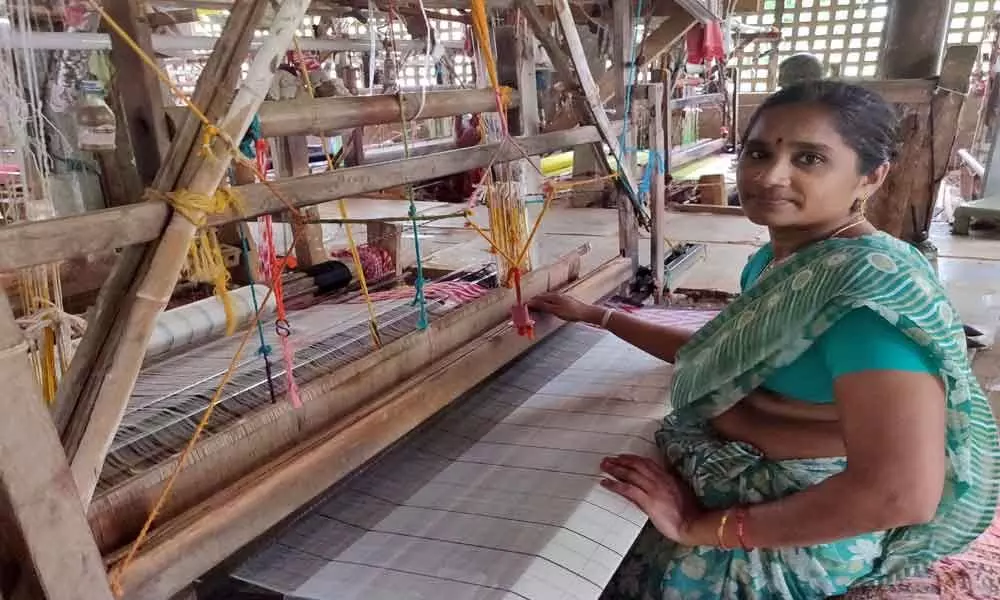Live
- Have time for jailed leaders but none for achievers: BJP slams Delhi govt over chess champion’s pain
- Alliance University holds 13th Convocation, 1145 students receive degrees
- SC orders strict action against illegal construction
- Man kills sibling over property dispute
- Karnataka gets third govt cardiology hospital
- Minister Ramalinga’s efforts help safeguard over 10,000 acres of temple Land
- Laxminarayan College gets NAAC B+ accreditation
- Champions Trophy: India vs Pakistan Match Likely to Be Held on This Date
- Tigress Zeenat spotted in Purulia
- Collectors asked for proper assessment of crop loss
Just In
It was late afternoon when I made my way to the tiny village of Mangalagiri on a rather gloomy July day. Praying fervently that the rain Gods do not make an ill-timed appearance, I got off my car at the village known for its weavers.
Weaving Magic
My first stop was to see how the yarn was made and what caught my attention was a long horizontal contraption held by wooden logs that had the threads being made for the fabrics. Interestingly almost all the villagers here are involved in the weaving process.
As I watched intrigued, I noticed that an entire family from the patriarch to the son, daughter in law and grandson were doing their bit to help make the yarn. As I walked a few steps away, I heard a rhythmic noise of wood clanging and discovered that I was just outside the weaver's workplace.
When I went in, I was surprised to see about ten handlooms with weavers busy at work. These are pit looms where the weavers sit on the ground and the loom is placed before them. The Mangalagiri saris are usually in fine cotton (yarn is sourced from neighbouring Chirala and Namburu towns) and are usually plain with a Nizam zari border, a hallmark of the sari.
A handloom sari typically takes at least two days to weave and naturally, the younger generation has either shifted to the city in search of better jobs or moved to power looms that produce hundreds of saris each day. However, the charm of the handloom sari is like no other and it is one of the best souvenirs that you can pick from one of the many retail stores here.
Spiritual Sojourn
Mangalagiri (means Auspicious - Mangala Hill - Giri) is also home to one of the oldest Vaishnavite Temples in South India the famed Sri Lakshmi Narasimha Swamy temple. The 11-storied lofty Temple Tower raises above everything here, making a compelling visual sight and was built by Raja Vasireddi Venkatadri Naidu between 1807 and 1809.
The deity here is said to be installed by the eldest Pandava, Yudhishtira and is a fine example of rock-cut architecture. There is another temple located on a hill is dedicated to Lord Panakala Narasimha Swamy and there is a very interesting story associated with the deity here.
The deity here has a large mouth into which jaggery water (called panakam) is offered by the devotees. All devotees hear a gurgling sound once they pour the same and always half the quantity of your offering I returned – irrespective of how much you have offered.
Also, in spite of the fact that so much jaggery water is around, you will not find a single ant here. I was here later in the day, so I had the chance to receive some of the jaggery water as prasadam and it certainly tasted divine. There are no pujas conducted here in the evenings as it is believed this is the time when Gods and sages worship the Lord.
Being located atop a hill, you can get a bird's eye view of the village from here too. As I stood watching the quaint town, I witnessed a stunning sunset and the whole sky turned a lovely hue of orange giving the village a beautiful tone, an image that will stay with me forever.

© 2024 Hyderabad Media House Limited/The Hans India. All rights reserved. Powered by hocalwire.com









